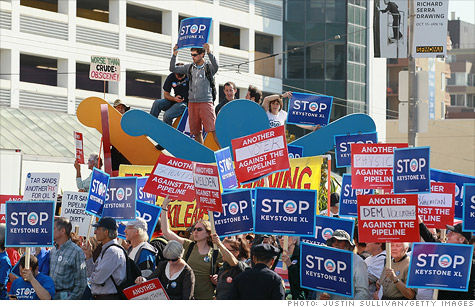Search News

Concerns over the water and air could derail the $7 billion Keystone pipeline project that promises thousands of jobs, millions of barrels of oil and billions in tax revenue.
NEW YORK (CNNMoney) -- Twenty thousand construction jobs. $5 billion in tax revenue. 700,000 barrels of additional oil a day.
All these things are now in doubt as opposition mounts to the expansion of the Keystone pipeline, a 1,700-mile long conduit that would carry crude from Canada's Alberta oil sands region to the U.S. Gulf Coast.
Just a few weeks ago analysts thought the jobs and economic benefits would easily outweigh environmental concerns and push the Obama administration to approve the $7 billion project.
But now Nebraska is balking at the pipeline's route, and rumblings of discontent are being heard from South Dakota as well.
The public pressure is being turned up too.
Protestors, concerned about green house gas emissions associated with Canada's oil sands and doubtful of its promised benefits, have been rallying against the project all summer. On Sunday, thousands joined hands and literally encircled the White House.
"Once thought to be a shoo-in, a near-term presidential approval of the pipeline looks less secure as opposition and headlines mount," Whitney Stanco, an energy analyst at the Washington Research Group, wrote in a note Monday. "We continue to believe the odds favor approval, but an extended delay is looking more and more possible."
Last week the state of Nebraska, through which the pipeline would pass, convened a special legislation to address the issue.
This week several bills are expected out of the state legislature. Those bills could require stricter construction standards where the pipeline would pass close to water resources.
They could also attempt to alter the course of the pipeline, directing it away from the Sand Hills region. The Sand Hills sit atop the massive Ogallala Aquifer, sacred to farming interests in the state.
"Nebraskans are concerned, and so am I, on why would you put a pipeline over the Ogallala Aquifer and risk an oil spill or leak," Nebraska Gov. Dave Heineman, a Republican, recently told a local paper.
The concern from Nebraska is causing analysts to rethink their position on the pipeline.
"Risks for Keystone XL at the US federal level remain low, but are rising at the state level in Nebraska," Robert Johnston, director of energy and natural resources at the political risk consultancy Eurasia Group wrote in a recent research note.
TransCanada (TRP), the company that wants to build the pipeline, maintains that pipelines are the safest way to carry crude oil.
The company has already agreed to install extra protections around the pipeline when it passes near water resources, and has put up a multi-million dollar bond to cover expenses should a spill occur.
But TransCanda is opposed to any rerouting of the pipeline, saying it would take years to obtain the new permits and cost million of dollars.
Last week the company posted a detailed legal analysis saying the federal government has sole authority over the pipeline's route now, and any attempt by the states to change it would be unconstitutional.
"If individual states could make these decisions, the decisions would be based on the limited interests of those states, potentially defeating broader national interests," the analysis said.
Because the pipeline crosses international borders its approval rests with the State Department.
Pipeline critics were heartened last week when President Obama indicated he'd take a direct role in the approval process. Obama had previously maintained a low profile on the issue.
Critics say building the pipeline not only risks spills but would lock the U.S. into dependency on a particularly dirty form of oil.
Oil sands are just that -- oil mixed with sand. To get a useful type of crude, heat is used to separate the oil from the sand. The process results in anywhere from 5% to 30% more greenhouse gas emissions than conventional oil would generate.
There are additional concerns over the effects on the land. Oil sands are often mined like coal, in huge open pits that destroy the forest and can contaminate the nearby rivers.
The companies that operate in the region, including the world's largest oil companies like ExxonMobil (XOM, Fortune 500), Royal Dutch Shell (RDSA) and BP (BP), have gotten better at mitigating the impacts, but concerns remain.
Pipeline opponents also allege the approval process at the Sate Department has been tainted by lobbyists for TransCanada that have close ties to the administration. On Monday the State Department's inspector general's office said it is conducting a review of the process.
Critics also dispute the benefits the pipeline would bring, pointing to a study from Cornell that said the pipeline could actually cost jobs by hurting the development of alternative energy and allowing for the export of oil from the Midwest and driving up the cost of gasoline in that region. ![]()
| Overnight Avg Rate | Latest | Change | Last Week |
|---|---|---|---|
| 30 yr fixed | 3.80% | 3.88% | |
| 15 yr fixed | 3.20% | 3.23% | |
| 5/1 ARM | 3.84% | 3.88% | |
| 30 yr refi | 3.82% | 3.93% | |
| 15 yr refi | 3.20% | 3.23% |
Today's featured rates:
| Latest Report | Next Update |
|---|---|
| Home prices | Aug 28 |
| Consumer confidence | Aug 28 |
| GDP | Aug 29 |
| Manufacturing (ISM) | Sept 4 |
| Jobs | Sept 7 |
| Inflation (CPI) | Sept 14 |
| Retail sales | Sept 14 |